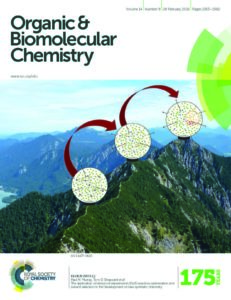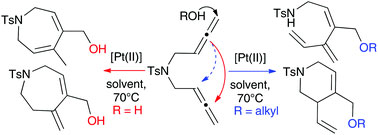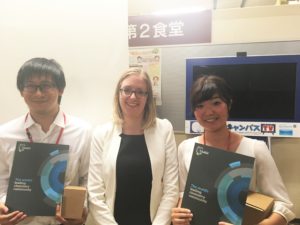
The articles below are some of the most read Organic & Biomolecular Chemistry articles in April, May and June 2017.
Review Articles:
Design and synthesis of analogues of natural products
Martin E. Maier
DOI: 10.1039/C5OB00169B
Transition-metal catalyzed valorization of lignin: the key to a sustainable carbon-neutral future
Markus D. Kärkäs, Bryan S. Matsuura, Timothy M. Monos, Gabriel Magallanes and Corey R. J. Stephenson
DOI: 10.1039/C5OB02212F
Selective chemical labeling of proteins
Xi Chen and Yao-Wen Wu
DOI: 10.1039/C6OB00126B
Site-selective incorporation and ligation of protein aldehydes
Richard J. Spears and Martin A. Fascione
DOI: 10.1039/C6OB00778C
1,3-Dipolar cycloadditions of azomethine imines
Carmen Nájera, José M. Sansano and Miguel Yus
DOI: 10.1039/C5OB01086A
Organocatalytic synthesis of axially chiral atropisomers
P. Renzi
DOI: 10.1039/C7OB00908A
The application of design of experiments (DoE) reaction optimisation and solvent selection in the development of new synthetic chemistry
Paul M. Murray, Fiona Bellany, Laure Benhamou, Dejan-Krešimir Bučar, Alethea B. Tabor and Tom D. Sheppard
DOI: 10.1039/C5OB01892G
Recent advances in the synthesis and application of fluorescent α-amino acids
Alexander H. Harkiss and Andrew Sutherland
DOI: 10.1039/C6OB01715K

Communications & Papers:
Amidation of unactivated ester derivatives mediated by trifluoroethanol
Christopher G. McPherson, Nicola Caldwell, Craig Jamieson, Iain Simpson and Allan J. B. Watson
DOI: 10.1039/C7OB00593H, Communication
A rapid and efficient one-pot method for the reduction of N-protected α-amino acids to chiral α-amino aldehydes using CDI/DIBAL-H
Jakov Ivkovic, Christian Lembacher-Fadum and Rolf Breinbauer D
OI: 10.1039/C5OB01838B, Communication
A protocol for amide bond formation with electron deficient amines and sterically hindered substrates
Maria E. Due-Hansen, Sunil K. Pandey, Elisabeth Christiansen, Rikke Andersen, Steffen V. F. Hansen and Trond Ulven
DOI: 10.1039/C5OB02129D, Communication
A NHC-catalyzed 1,3-dipolar cycloaddition reaction of allyl ketones with azides: direct access to 1,4,5-trisubstituted 1,2,3-triazoles
Huijun Yuan, Lili Zhang, Zhantao Liu, Yang Liu, Jian Wang and Wenjun Li
DOI: 10.1039/C7OB00906B, Communication
A novel off–on fluorescent probe for sensitive imaging of mitochondria-specific nitroreductase activity in living tumor cells
Bo Huang, Wen Chen, Yong-Qing Kuang, Wei Liu, Xian-Jun Liu, Li-Juan Tang and Jian-Hui Jiang
DOI: 10.1039/C7OB00781G, Communication
FeCl3 catalysed 7-membered ring formation in a single pot: a new route to indole-fused oxepines/azepines and their cytotoxic activity
K. Shiva Kumar, Meesa Siddi Ramulu, Bandari Rajesham, N. Praveen Kumar, Vani Voora and Rama Krishna Kancha
DOI: 10.1039/C7OB00715A,Paper
Copper-catalyzed oxidative decarboxylative coupling of α-keto acids and sulfoximines
Chaleena Pimpasri, Ladawan Sumunnee and Sirilata Yotphan
DOI: 10.1039/C7OB00776K, Paper
Tf2NH-catalyzed formal [3 + 2] cycloaddition of oxadiazolones with ynamides: a simple access to aminoimidazoles
Yingying Zhao, Yancheng Hu, Xincheng Li and Boshun Wan
DOI: 10.1039/C7OB00701A, Communication
Cyclic dipeptide based cell-penetrating peptidomimetics for effective DNA delivery
Chilakapati Madhu, Chandrashekhar Voshavar, K. Rajasekhar and Thimmaiah Govindaraju
DOI: 10.1039/C7OB00167C, Communication
Synthesis, properties, and crystal structures of π-extended double [6]helicenes: contorted multi-dimensional stacking lattice
Takao Fujikawa, Nobuhiko Mitoma, Atsushi Wakamiya, Akinori Saeki, Yasutomo Segawa and Kenichiro Itami
DOI: 10.1039/C7OB00987A, Paper
Urotensin-II peptidomimetic incorporating a non-reducible 1,5-triazole disulfide bond reveals a pseudo-irreversible covalent binding mechanism to the urotensin G-protein coupled receptor
Salvatore Pacifico, Aidan Kerckhoffs, Andrew J. Fallow, Rachel E. Foreman, Remo Guerrini, John McDonald, David G. Lambert and Andrew G. Jamieson
DOI: 10.1039/C7OB00959C, Paper
Enantioselective total synthesis of (+)-arborescidine C and related tetracyclic indole alkaloids using organocatalysis
Vishal M. Sheth, Bor-Cherng Hong and Gene-Hsiang Lee
DOI: 10.1039/C7OB00473G, Communication
Asymmetric synthesis of CF3-containing tetrahydroquinoline via a thiourea-catalyzed cascade reaction
Yuanyuan Zhu, Boyu Li, Cui Wang, Zhenghao Dong, Xiaoling Zhong, Kairong Wang, Wenjin Yan and Rui Wang
DOI: 10.1039/C7OB01013C, Communication
Palladium-catalyzed Suzuki–Miyaura coupling of amides by carbon–nitrogen cleavage: general strategy for amide N–C bond activation
Guangrong Meng and Michal Szostak
DOI: 10.1039/C6OB00084C, Paper
Ru(II)-Catalyzed annulation of benzamidines and alkynes by C–H/N–H activation: a facile synthesis of 1-aminoisoquinolines
P. P. Kaishap, G. Duarah, D. Chetia and S. Gogoi
DOI: 10.1039/C7OB00389G, Paper
2,2,2-Trifluoroethanol as a solvent to control nucleophilic peptide arylation
Diana Gimenez, Anica Dose, Nicholas L. Robson, Graham Sandford, Steven L. Cobb and Christopher R. Coxon
DOI: 10.1039/C7OB00295E, Communication
Regioselective 6-endo–dig iodocyclization: an accessible approach for iodo-benzo[a]phenazines
Sonu Kumar, Mohammad Mujahid and Akhilesh K. Verma
DOI: 10.1039/C7OB00671C, Paper
Keep up-to-date with the latest issues of Organic & Biomolecular Chemistry with our E-alerts














